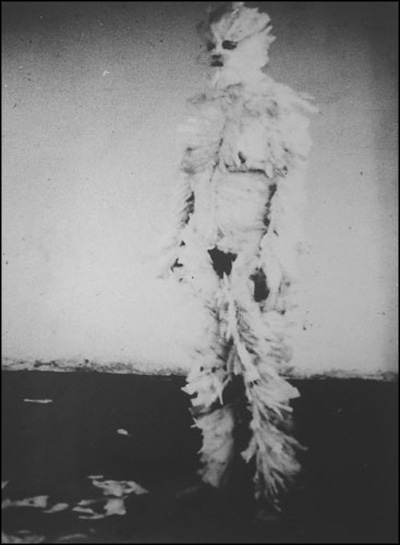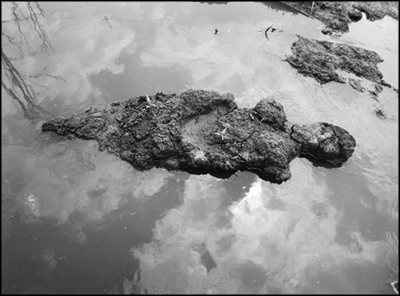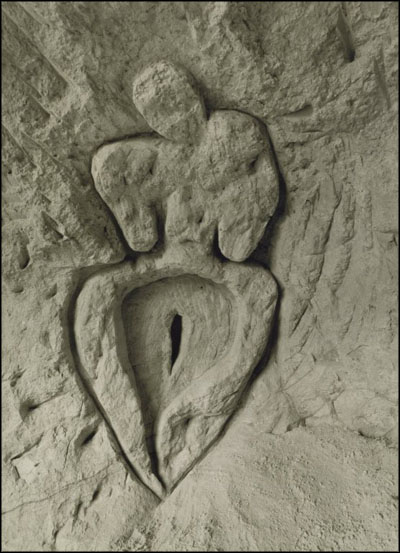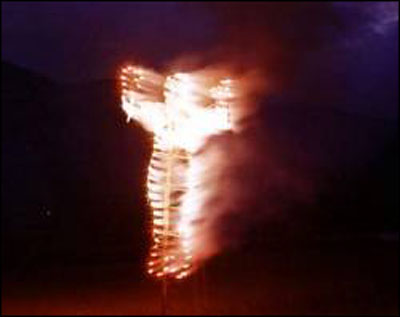Remembering Ana Mendieta
Tonight, I can’t stop thinking about one of the more influential, yet relatively obscure artists at work during the post-Happenings decade. Ana Mendieta:

From Ana Mendieta’s “Body Tracks” series, 1970s.
It’s all too easy to scoff at raw, bloody, chthonic feminist performance art these days. Hell, it’s all too easy to scoff at just about anything that whiffs of pussy power. After all, this is 2010! No need for histrionics, right? We’ve been liberated, reborn. We’re fierce and comfortable, right? We’ve seen it all a hundred times before… rrrriiiiiight?
Then again, what Alice Miller said about scorn holds a lot of sway: “Contempt is the weapon of the weak and a defense against one’s own despised and unwanted feelings.” In light of that assessment, whether one chooses to roll their eyes or not, Mendieta’s (earth-)body of work, and the circumstances under which she died, resonate as much right now as they did in the 1970s and early 80s. (Although, come to think of it, there were plenty of eye-rollers then, too.)
In any case, on the 15th anniversary of her mysterious death, I’m lighting candles for Ana Mendieta and wondering what comes next.

Untitled performance, 1972.
Ana Mendieta (18 November 1948 – 8 September 1985) was a Cuban-American interdiscplinary artist. From 1972 to 1985, she produced numerous films, videos, site-specific installations, prints, drawings, sculptures, organic assemblage pieces, and performances. From Wiki:
Much of Mendieta’s work may be considered strongly feminist by some; it is in essence autobiographical. One theme in her early performance art was violence against the female body. Later, Mendieta focused on a spiritual and physical connection with the land […] which typically involved carving her imprint into sand or mud, making body prints or painting her outline or silhouette onto a wall. During the last 2 years of her life she started creating “objects”, mostly permanent sculptures and drawings. It was her intention to retain the connection with nature via the vibrations of the natural elements she continued to use in the works.

Feather Woman, early 70s.
Her “earth-body art” is a fusion of two movements: earth art and body art. “I have been carrying on a dialogue between the landscape and the female body (based on my own silhouette)… I am overwhelmed by the feeling of having been cast from the womb (nature). Through my earth/body sculptures I become one with the earth… I become an extension of nature and nature becomes an extension of my body…”
With her Silueta series (perhaps her best known work), Mendieta sculpted the female body, or its imprint, from blood, earth, wood, gunpowder, flowers, leaves, weeds, sand, her own flesh. These imprints were then photographed or captured with Super-8 film.

“Arbol de la Vida” and “Imagen de Yagul” from her Silueta series, late 70s.

Another image from her “Body Tracks” series.

Examples of Mendieta’s work as a grad student in Iowa, early 70s.
Mendieta was born in Havana. In 1961, aged thirteen, she was exiled from Cuba along with her older sister, Raquelin. Her parents, vocal opponents of the revolutionary government, decided it was not safe for their girls to stay. The Mendieta sisters relocated to Iowa, where they were shuffled in and out of various government institutions and foster homes. Conditions were harsh and sometimes downright abusive. Beatings, isolation, bullying, etc. Mendieta persevered. When she was 17, her mother and brother rejoined in the States. By then, her father was in a Cuban prison, and she would not see him again for many years.

Untitled, 1976.
Mendieta went to college, earning her Bachelor’s degree from the University of Iowa in 1969, an MA in Painting, and eventually an MFA in Intermedia. In her early twenties, she abandoned more traditional modes of artistic expression, saying “the turning point in art was in 1972, when I realized that my paintings were not real enough for what I want the image to convey and by real I mean I wanted my images to have power, to be magic.”

Isla, 1981.

Earth Goddess, early 80s. “There is no original past to redeem; there is the void, the orphanhood […] There is above all the search for origin.” Ana Mendieta
Over the course of her brief but prolific career, she lived and worked predominantly in NYC, but also spent time creating works in Mexico, Italy, even her homeland of Cuba. Themes of rape, revolution and blood dominated her early work, then she moved on to more abstract feminine themes, with pieces that explored the boundaries of humanity with nature, personal identity and universal belonging.

Glass on Body Imprints series (1972)
She was, according to accounts from friends, family and colleagues, a passionate and feisty young woman with a lot of ambition and forward momentum. She could be self-absorbed and difficult, but also capable of heartfelt displays of affection and gratitude to her loved ones.
She died on this day in 1985 after falling from the open window of an apartment on the 34th floor of a building in Greenwich Village. The only possible witness to her death was her husband, famed minimalist sculptor Carl Andre, who she had married eight months earlier. An affluent, accomplished darling of the museum circuit in NYC, Andre was tried for murder, and eventually acquitted in 1987. His lawyer described Mendieta’s death as accidental, perhaps a suicide.

However, police investigators and journalists, as well as dozens of Mendieta’s outspoken friends, remain unconvinced. A doorman on the street testified that he heard Ana screaming “no, no, no” in the moments before her death. Pleading, he said. Andre later made contradictory statements to those he gave detectives who came to his home in the wee hours of the morning after he called 911. There were scratch marks on Andre’s face and arms and signs of a struggle in the apartment.
The exact cause of Ana Mendieta’s death may never be known.
Now in his seventies, Carl Andre still lives and works in NYC, averaging two to three exhibitions a year.
Several posthumous Mendieta curations over the past decade have done much to mend the huge rift that opened up in NYC cultural circles in response to the shocking nature of her death, and the subsequent, supposed whitewashing of Andre’s reputation. After viewing the Whitney’s 2004 retrospective of Mendieta’s work, her colleague and teacher, John Perreault, said:
You can tell that Ana Mendieta is about to make it into art history: her last name only is on the cover of the dramatic, blood-red catalogue that accompanies the new survey of her art now at the Whitney.
When I saw that, it gave me shivers.
All is forgiven, Art World. She broke a lot of boundaries; she broke a lot of rules. Her shocking death for a time divided the art world, but now we can be healed.
…Right?

Untitled (From Silueta Works in Mexico)

September 9th, 2010 at 12:31 pm
I find her work to be a lot more interesting and three dimensional than the scores upon scores of modern female artists today making work that focuses on lolita-sexuality with very little evident self reflection.
There’s plenty to be angry about. We’re not all liberated kommerades living in a gender utopia, and I feel like I’m reminded every day that my status as female forms an unbreakable and often violent frame around my life, my career, my right to agency. I realize I’m preaching to the choir; my words are meant as a celebration of an artist whose work I feel is still relevant today and who is unjustly minimalized next to her male contemporaries even in the context of earth art. I promise every art history class that covers the post-war era has a picture of Spiral Jetty in its textbook, but you’d be lucky to find any mention of Mendieta outside of a brief section on women or cubano artists.
September 9th, 2010 at 1:30 pm
I had never heard of Ana Mendieta but I find myself moved by her expression, her art.
This may be quite a stretch, but I see more to this than just feminism. Her expression of the connection between our bodies and the earth is more relevant than ever, if you put it in terms of natural diasters like the BP oil spill affecting every part of the food chain, including ourselves.
This may sound odd, but her images also brought to mind the Jewish concept of the Shekinah, often described as the female aspect of God, an indwelling presence within earthly forms often used to communicate with humanity.
I wonder if she would’ve gone on to express our galactic roots, our shared composition with stardust?
September 9th, 2010 at 1:38 pm
Mer, thank you so much for this.
I didn’t know about Ana Mendieta before I read about her here,
and this introduction/eulogy to her was very moving and very
important for me to experience. Powerful woman, powerful work.
September 9th, 2010 at 4:15 pm
“I find her work to be a lot more interesting and three dimensional than the scores upon scores of modern female artists today making work that focuses on lolita-sexuality with very little evident self reflection. ”
I wholly and passionately agree with you, Celine. Not enough introspection or examination happening. Too much focus on who’s looking, not enough on looking inward.
“I promise every art history class that covers the post-war era has a picture of Spiral Jetty in its textbook, but you’d be lucky to find any mention of Mendieta outside of a brief section on women or cubano artists.”
Oof. I know. It’s shit. Have you read that book “Where is Ana Mendieta?” The title is taken from signs carried by protesters outside of the Guggenheim in the early 90s to “conspicuous absence of women artists from high-profile exhibitions.”
Things are a little better in some ways, worse in others, completely unchanged in many more, and I guess that’s why I couldn’t resist a little sarcasm in my intro. Not scornful, mind you, just… eh? Eh?!! *nudgenudge* Because I think Mendieta’s work still resonates with such power and pain and beauty, and I wish we weren’t so quick to dismiss it or compartmentalize it as passe.
It’s tragic that knowledge of the manner in which Mendieta died has eclipsed the body of work itself. I’m glad that the Whitney, as well as other museums and schools, have begun making attempts to change that.
“This may be quite a stretch, but I see more to this than just feminism.”
Jennifer, I agree with that, too. The manner in which she expresses these universalities has SO much to do with her sex. Vagina, womb, bloody slits, breasts, the recurring female silhouette… it’s so fiercely, ungovernably gender female. But underneath that, there’s something infinitely more personal AND more cosmic going on.
The Shekinah comparison makes a lot of sense, too.
September 9th, 2010 at 4:16 pm
You’re welcome, Angelkins. Mendieta’s work is right up your alley, most definitely!
September 9th, 2010 at 7:31 pm
Huh. I majored in art history, focused particularly on art in the 60s-70s-80s, learned all about Carl Andre…and never learned a thing about Mendieta. Thanks for this post, very interesting.
September 13th, 2010 at 1:03 am
I have been a massive fan of Mendieta’s work since I first heard of her, in Art School. I was doing a lot of work with mud and footprints, and someone suggested I should look her up.
I never realised how suspect the circumstances around her death were, nor that she was married to Carl Andre.
Thanks for all these extra links to works by her, she is seriously under-documented in my opinion, so it’s nice to see more of her work.
February 27th, 2012 at 8:52 am
I love this woman’s work. My goodness, i too studied art history and focussed on feminist art and never heard of Ana. Such powerful beautiful artistic expressions. I find the art of the 70’s still so moving and heart felt as if it is gathering profundity as time passes and women remain objectified and undermined in their difference to men. Surely the birth culture in the west, the portrayal of menstruation as a “hygiene issue”, as penetrative sex as the apotheosis of sexaul expression should be being challenged. Dear Ana, such an inspiration. Such an awful end.
January 6th, 2013 at 9:47 am
While everybody was complaining about the absence of Ana Mendieta in arts education in 2010, the English “Open University” already had a book available as part of its art history course (produced in team with Yale Uni Press) called “Frameworks for Modern Art” which has a long chapter by Gill Perry on Ana (5 chapters in a 250-page book).
Her “Silueta” in the history of modern art still has her figure in it, she *was*, and she still *is*.
As for “women being objectified” – unfortunately the expanding field of postmodernism of which she was a part was fated to become a piece of the wider sphere of popular culture – it’s what happens when you make art accessible – but the downside is that the arts rubs shoulders with many more pervasive cultural processes which will continue to fetishise women (in appearance) and not look for depth even if the traditional arts move that way. The arts movement is one of the most gender/sexuality tolerant spheres of human endeavour, but the arts becoming part of the wider mass culture (or at least now competing on the same playing field) serves to dilute its power. I’d love for this to be different, but that’s how I perceive the overall picture.
http://www.amazon.com/Frameworks-Modern-Art-Twentieth-Century/dp/0300102283 holds an objective look at her Siluetas, and has since 2003/4. Rest assured that many art history students are at least being educated about her existence, her work, and the gendered nature of art.